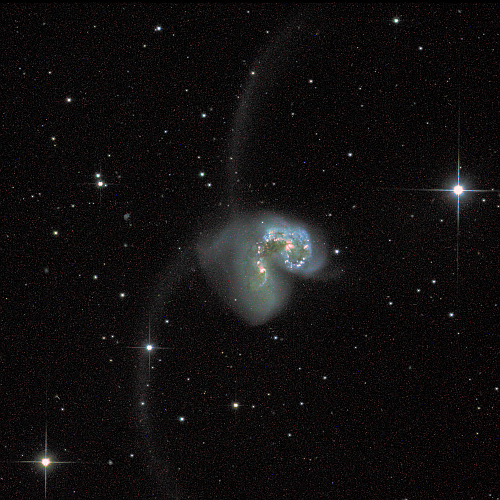SuperBIT high altitude astronomical balloon completes mission

The Antennae galaxy, one of four SuperBIT images released.
Click for original image.
After almost forty days circling Antarctica and taking high resolution images of galaxies and nebula, NASA SuperBIT high altitude astronomical balloon completed its mission today, landing in Argentina.
Having identified a safe landing area over southern Argentina, balloon operators from NASA’s Columbia Scientific Balloon Facility in Palestine, Texas, sent flight termination commands at 8:37 a.m. EDT, May 25. The 18.8-million-cubic-foot (532,000-cubic-meter) balloon then separated from the payload rapidly deflating, and the payload floated safely to the ground on a parachute touching down in an unpopulated area 66 nautical miles (122 kilometers) northeast of Gobernador Gregores, Argentina. NASA coordinated with Argentine officials prior to ending the balloon mission; recovery of the payload and balloon is in progress.
During its nearly 40-day journey, the balloon completed a record five full circuits about the Southern Hemisphere’s mid-latitudes, maintaining a float altitude around 108,000 feet. In the coming days, the predicted flight path would have taken the balloon more southerly with little exposure to sunlight, creating some risk in maintaining power to the balloon’s systems, which are charged via solar panels. The land-crossing created an opportunity to safely conclude the flight and recover the balloon and payload.
The picture above, cropped, reduced, and sharpened to post here, has incredible resolution, illustrating the advantage of flying a telescope on a high altitude balloon.
On Christmas Eve 1968 three Americans became the first humans to visit another world. What they did to celebrate was unexpected and profound, and will be remembered throughout all human history. Genesis: the Story of Apollo 8, Robert Zimmerman's classic history of humanity's first journey to another world, tells that story, and it is now available as both an ebook and an audiobook, both with a foreword by Valerie Anders and a new introduction by Robert Zimmerman.
The print edition can be purchased at Amazon or from any other book seller. If you want an autographed copy the price is $60 for the hardback and $45 for the paperback, plus $8 shipping for each. Go here for purchasing details. The ebook is available everywhere for $5.99 (before discount) at amazon, or direct from my ebook publisher, ebookit. If you buy it from ebookit you don't support the big tech companies and the author gets a bigger cut much sooner.
The audiobook is also available at all these vendors, and is also free with a 30-day trial membership to Audible.
"Not simply about one mission, [Genesis] is also the history of America's quest for the moon... Zimmerman has done a masterful job of tying disparate events together into a solid account of one of America's greatest human triumphs."--San Antonio Express-News

The Antennae galaxy, one of four SuperBIT images released.
Click for original image.
After almost forty days circling Antarctica and taking high resolution images of galaxies and nebula, NASA SuperBIT high altitude astronomical balloon completed its mission today, landing in Argentina.
Having identified a safe landing area over southern Argentina, balloon operators from NASA’s Columbia Scientific Balloon Facility in Palestine, Texas, sent flight termination commands at 8:37 a.m. EDT, May 25. The 18.8-million-cubic-foot (532,000-cubic-meter) balloon then separated from the payload rapidly deflating, and the payload floated safely to the ground on a parachute touching down in an unpopulated area 66 nautical miles (122 kilometers) northeast of Gobernador Gregores, Argentina. NASA coordinated with Argentine officials prior to ending the balloon mission; recovery of the payload and balloon is in progress.
During its nearly 40-day journey, the balloon completed a record five full circuits about the Southern Hemisphere’s mid-latitudes, maintaining a float altitude around 108,000 feet. In the coming days, the predicted flight path would have taken the balloon more southerly with little exposure to sunlight, creating some risk in maintaining power to the balloon’s systems, which are charged via solar panels. The land-crossing created an opportunity to safely conclude the flight and recover the balloon and payload.
The picture above, cropped, reduced, and sharpened to post here, has incredible resolution, illustrating the advantage of flying a telescope on a high altitude balloon.
On Christmas Eve 1968 three Americans became the first humans to visit another world. What they did to celebrate was unexpected and profound, and will be remembered throughout all human history. Genesis: the Story of Apollo 8, Robert Zimmerman's classic history of humanity's first journey to another world, tells that story, and it is now available as both an ebook and an audiobook, both with a foreword by Valerie Anders and a new introduction by Robert Zimmerman.
The print edition can be purchased at Amazon or from any other book seller. If you want an autographed copy the price is $60 for the hardback and $45 for the paperback, plus $8 shipping for each. Go here for purchasing details. The ebook is available everywhere for $5.99 (before discount) at amazon, or direct from my ebook publisher, ebookit. If you buy it from ebookit you don't support the big tech companies and the author gets a bigger cut much sooner.
The audiobook is also available at all these vendors, and is also free with a 30-day trial membership to Audible.
"Not simply about one mission, [Genesis] is also the history of America's quest for the moon... Zimmerman has done a masterful job of tying disparate events together into a solid account of one of America's greatest human triumphs."--San Antonio Express-News


532,000-cubic-meter
Is that big? 4/3(pi)r^3, right? I get 50 meter radius, so diameter larger than a football field (American). Yep. That’s a big balloon.